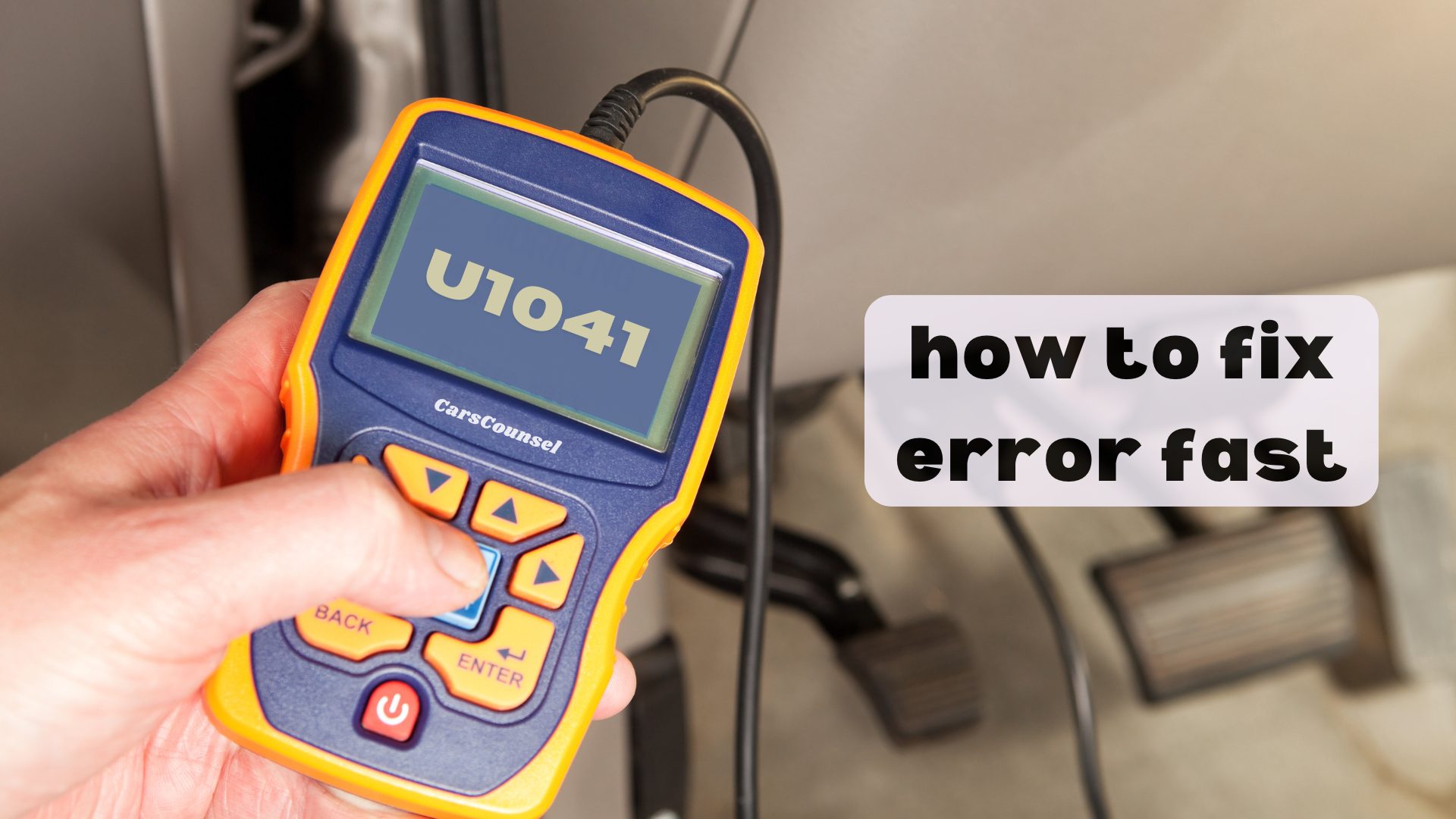Imagine you’re driving your Chevy Tahoe when suddenly, the check engine light comes on, and a quick scan shows the U1041 code. You might think fixing it will be a hassle, but it doesn’t have to be.
Start by checking for other related error codes, inspect the wiring and connectors, and test the ECM for any problems. Loose connections are often the cause.
Want to prevent this from happening again? There’s a simple way to keep your vehicle running smoothly.

Quick Navigation
Key Takeaways
- Use a code scanner to find and identify the U1041 code and any related codes.
- Check and secure all wiring and connectors, making sure there are no loose connections or damages.
- Test the ECM for proper voltage and ground signals; replace it if needed.
- Look at the ABS and traction control modules for errors or bad connections.
Understanding U1041 Code
Understanding the U1041 code is crucial, as it indicates communication problems between your car’s Engine Control Module (ECM) and other important controllers, affecting the vehicle’s overall performance.
The U1041 code’s impact is significant because it can lead to various system malfunctions, hurting fuel efficiency and causing power loss.
To address this issue, you need to thoroughly check the communication system. Start by inspecting all related wiring and connectors for any damage or looseness.
Use an OBD-II scanner to read any additional codes. Check the ECM and other controllers like the ABS to ensure they’re working correctly.
Finding the root cause quickly can prevent more problems and keep your car running smoothly.
Symptoms of U1041 Code
When your vehicle shows a U1041 code, you might see dashboard warning lights, have weird electronic problems, and notice performance issues like less power or trouble starting. Catching these signs early can stop more damage. Here’s what to watch for:
- Dashboard Warning Lights: Lights for ABS, traction control, or check engine often come on, indicating communication problems.
- Erratic Electronics: Things like your radio, AC, or dashboard might act up.
- Performance Issues: You could have slower acceleration, worse gas mileage, or even trouble starting the car.
Fixing these issues quickly is crucial to keep your car running well. Use diagnostic tools to check for the U1041 code and make the necessary repairs to restore proper communication between your car’s control modules.
Common Causes of U1041
The U1041 code usually happens because of several issues, like a bad ECM, loose connections, or broken controllers.
When the ECM (Engine Control Module) isn’t working right, it messes up communication between important systems in your car. Loose or damaged wires and connectors can also block signals and cause this error code. Other controllers, like the ABS (Anti-lock Braking System), might fail and trigger the code too.
Electrical problems, such as blown fuses, short circuits, and corroded wiring, are common causes. You can use diagnostic tools to find these problems accurately.
Regular car maintenance helps spot these issues early, preventing the U1041 code from showing up. Fixing software glitches and making sure all connections are secure is important for keeping your car’s electronic systems working properly.
Affected Vehicle Models
Many car models, including the Cadillac CTS, GMC Sierra, and Hummer H2, often show the U1041 code because of problems with their electronic controls. These issues usually come from the complex network of electronics that run important systems in the car.
Here are some common problems for these specific models:
- Cadillac CTS: This model often has U1041 codes because the electronic brake control module fails.
- GMC Sierra: This truck is known for U1041 codes due to problems with the ABS module or wiring issues.
- Hummer H2: This vehicle frequently shows U1041 codes because of faulty wheel speed sensors.
Knowing these common issues for each model can help you understand and fix the U1041 code in your car.
Identifying Related Codes
Start by looking for any related codes, as these can give you more context and help identify what’s causing the U1041 error.
Use diagnostic tools to scan the vehicle’s system for other error codes. Often, codes like U1000 or U1016 show up alongside U1041, indicating bigger communication issues.
Your diagnostic tools will log these errors, giving you a better idea of the vehicle’s electronic health.
Review the error log to spot any patterns or recurring problems. This step-by-step approach helps you understand the problem’s scope and decide which repairs to prioritize.
Identifying related codes early will save you time and ensure a more accurate diagnosis of the U1041 error.
Inspecting Wires and Connectors
Begin by carefully looking at all the wires and connectors linked to the ECM and other controllers to spot any signs of damage or looseness. Making sure the wires are in good condition and the connectors are well-maintained is crucial. Here’s what you need to do:
- Look at the Wires: Check for any fraying, cuts, or rust. Damaged wires can mess up communication.
- Check the Connectors: Make sure the connectors are tightly connected and clean, without any dirt or rust. Loose or dirty connectors can block signals.
- Test with a Multimeter: Use a multimeter to test suspect wires for continuity, ensuring they aren’t broken inside.
Testing the ECM
Checking the ECM (Engine Control Module) involves using special diagnostic tools to find any problems or irregularities in how it works. Start by connecting an OBD-II scanner to get trouble codes.
Use ECM diagnostics to check the voltage and ground signals at the control module. Look for any issues that could mean there’s a problem. If the ECM doesn’t pass these tests, you might need to think about replacing it.
Make sure the new ECM is programmed correctly to match your vehicle’s specs. This can fix communication issues and get things working right again. Always clear the codes after replacing the ECM and take the car for a test drive to make sure the problem is fixed.
Good diagnostics are key to solving the U1041 code effectively.
Assessing Controllers
When checking controllers, make sure you carefully look at the ABS and traction control modules to see if they’ve any issues. These systems are crucial for keeping the vehicle safe and running well.
Start by focusing on how the controllers communicate with the Engine Control Module (ECM).
Here’s what to do:
- Run Diagnostic Tests: Use a special OBD-II scanner to find any error codes related to the controllers.
- Check Electrical Connections: Make sure all connections are tight and not rusty, since bad connections can mess up communication.
- Examine Controller Functionality: Test the ABS and traction control modules to make sure they’re working properly.
Fixing Loose Connections
How do you fix loose connections to resolve the U1041 code and get the vehicle’s controllers and ECM talking again?
First, regular maintenance is key. By checking things regularly, you can prevent loose connections from becoming a problem.
Here’s what you’ll need: a multimeter, wire strippers, and electrical tape.
Start by looking at the connectors and wires for any damage or rust. Use the multimeter to check if the wires are still connected properly.
If you find any loose or damaged wires, strip the ends, twist them together, and secure them with electrical tape or proper connectors.
Preventing U1041 Recurrence
To prevent the U1041 code from coming back, it’s important to keep an eye on your vehicle’s ECM and wiring connections.
Here are some simple steps you can follow:
- Check Regularly: Look at the ECM connections and wiring often to spot any damage, rust, or loose connections.
- Update Software: Make sure your vehicle’s software is current to avoid any bugs that might cause the U1041 code.
- Keep an Eye on Controllers: Regularly test controllers like the ABS to catch and fix any problems early.
More OBD-II Codes
Frequently Asked Questions
How Long Does It Typically Take to Diagnose a U1041 Code?
Figuring out a U1041 code usually takes about 1-2 hours. You’ll need some diagnostic tools to get the code, check things like wires and connectors, look at the controllers, and test the ECM for any problems.
Are There Any Temporary Fixes for the U1041 Code?
When you’re in a pinch, think of temporary solutions as a quick fix. Use diagnostic tools to clear the code for now, check and secure any loose connections, and inspect the fuses. However, you’ll need professional repair for a lasting solution.
What Are the Costs Associated With Repairing a U1041 Code?
Fixing a U1041 code can cost you anywhere from $100 to $1,000, depending on how complicated the problem is. Just figuring out what’s wrong usually starts at about $100. If you need to replace things like the ECM (Engine Control Module) or other controllers, it’ll be more expensive. It’s a good idea to ask your mechanic for an estimate.
Can the U1041 Code Affect Vehicle Safety Systems?
Yes, the U1041 code can impact your vehicle’s safety systems. Symptoms include problems with the ABS and traction control. It’s important to run a diagnostic check and fix any issues right away to keep your safety systems working properly.
Is It Safe to Drive With a U1041 Code Present?
Driving with a U1041 code can be risky. It may affect important safety systems like ABS or traction control. Use diagnostic tools to find and fix the problem as soon as possible. Always put safety first.
Conclusion
To sum it up, fixing the U1041 code quickly can help you avoid bigger, more expensive repairs later.
Did you know that more than 60% of U1041 problems are due to basic wiring issues?
By using an OBD-II scanner, checking connections, and testing the ECM, you can deal with this error directly.
Remember, regular maintenance is crucial for preventing future problems.
Stay on top of it, and your vehicle will run smoothly.

